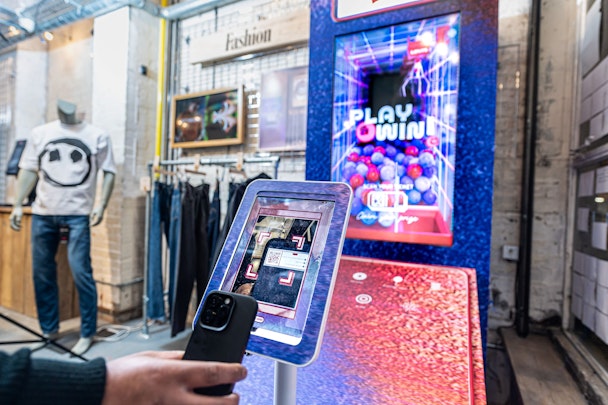Introducing invisible commerce – a retail brand experience designed for the future
The physical retail store will always be a place where products exist, but the store of the future will be built around tech-enabled brand experiences where commerce practically disappears.

The merging of the physical and digital worlds has paved the way for invisible commerce
Retail as we know it might be a thing of the past, but the new era of the bricks and mortar store is just around the corner – and it’s more connected than ever. While the 4Ps of marketing (product, price, place and promotion) still apply in the quest to drive sales, the merging of the physical and digital worlds has paved the way for a new strategic superpower for the store: invisible commerce.
Online commerce has become an essential part of retail, with global e-commerce sales forecast to hit $6.3tn in 2023. At the same time, physical retail real estate is experiencing a revival. In a post-pandemic world, research from Capgemini Research Institute found that 72% of global consumers expected their interactions with physical stores to surpass pre-pandemic levels.
Amid the intersecting effects of the pandemic, the climate crisis, inflation and technological advancements, consumer expectations are constantly evolving but their desire to move easily and seamlessly between their online and in-store retail experience means an omnichannel approach is key. However, the future of the physical store won’t be driven by commerce, but by experiences.
Advertisement
“The store is always going to be a place where products exist and people buy them,” explains Steve Hewett, the vice-president and customer transformation and CX tech leader at Frog. “But the idea of walking around aisles, picking stuff up and going to the checkout will have to disappear to make someone want to go to a store. That gap needs to be filled with experiences so that commerce becomes just a thing happening transparently in the background – and that’s what technology is enabling.”
A new shopping experience
The economy is struggling; consumers and brands alike are feeling the impact. As a result, purchase habits have changed and brands face a new challenge in balancing their purpose against the reality of price. The differentiator becomes the experience, finding new ways to offer added value.
“Take that back to the shopping experience and the challenge for brands in balancing profit with purpose is going to be really important this year,” says Hewett. “Retailers can’t just switch off their purpose agenda, but equally they can’t just discount their way out of things because they can’t afford to and customers can’t afford to pay a premium for purposeful stuff. It’s a complex equation to solve, but one that gives brands an opportunity to transform the shopping experience.”
Today’s consumer is shopping in multiple channels and their expectations of the in-store experience have evolved. Research shows that 72% of digital shoppers consider in-store experiences to be the most important channel when making a purchase – that’s where brands should be placing their bets.
Advertisement
Technology as an enabler
While the potential applications for artificial intelligence (AI) might be dominating chatter in digital marketing circles, it’s also playing a crucial role in transforming traditional bricks and mortar from a commerce experience to a brand experience, with technology unlocking a new level of insight from ‘physical’ data, that hasn’t been possible before.
Technologies such as camera analytics, edge computing, headless commerce platforms and in-store sensors are combining into powerful cloud platforms to redefine what is possible, removing friction in the customer journey to create value. This empowers customers by enabling seamless transitions between online to offline and gives physical interactions a digital footprint by unlocking insight.
“You’ve got this perfect storm emerging where the core technology engines that make retail happen are becoming obsolescence,” says Hewett. “Converging point-of-sale and online platforms is an opportunity to ensure you have a future-fit infrastructure in place that can enable all of this – and that’s the key to unlocking invisible commerce.”
Suggested newsletters for you
Reimagining physical retail spaces
To address customers’ desire for unique discovery experiences and on-demand convenience, stores must be positioned to compete for and win their customers’ hearts and minds to deliver new forms of value. That requires new ways of thinking about how the store is designed to connect with customers, presenting some clear focus areas for future store strategies.
Key to this is to ensure the space caters to a specific need whether it be to inspire, connect, express, educate, energize, explore, entertain or unwind. Once the purpose of the store is defined, Frog outlines six transformative archetypes to consider, as well as brands to look to for inspiration:
- The Showroom: putting ‘show and tell’ front and center with access to experts, eg Apple and Sonos
- The Playground: a space for imagination and exploration to take over, eg Lego House and Dick’s Sporting Goods
- The Clubhouse: a hub for like-minded customers to connect, eg Rapha and Rivian
- The Oasis: a tranquil space to create a refuge from traditional shopping and daily stressors, eg The Real Real and Aesop
- The Studio: a space for customers to co-create, experiment and customize, eg Lowe’s and Glossier
- The Garden: a place to repair, restore and recycle goods in line with values, eg Nordstrom and Selfridges
“The landscape has changed and brands should stop obsessing over the transactional, efficiency-driven game and instead master the experience economy, for which stores are the prime stage,” says Hewett. “It’s prime time to unlearn everything you think you know about the optimized store and adapt for this new future to discover and deliver experiences that create an online halo effect.”
For more inspiration and advice to help elevate your store to the next level, visit here.
Content created with:

Capgemini
Capgemini is a global leader in partnering with companies to transform and manage their business by harnessing the power of technology. The Group is guided everyday...
Find out more
